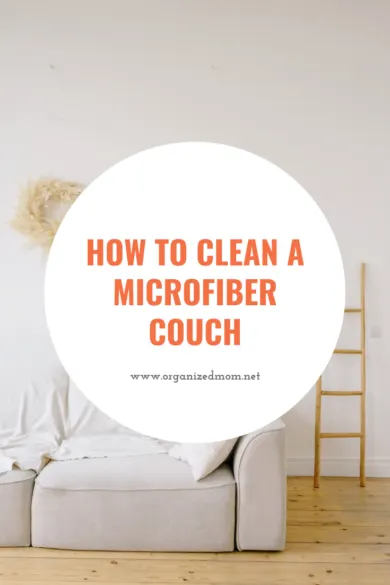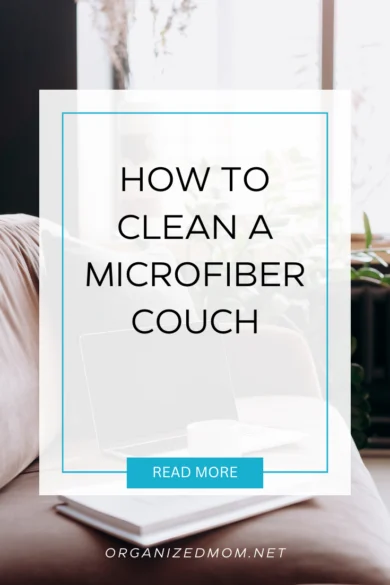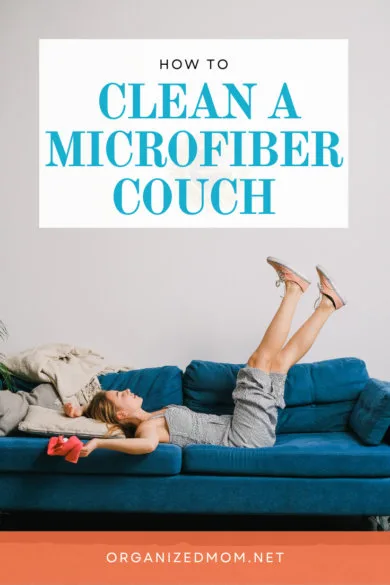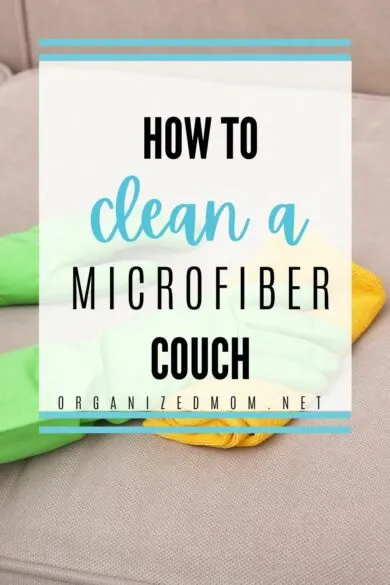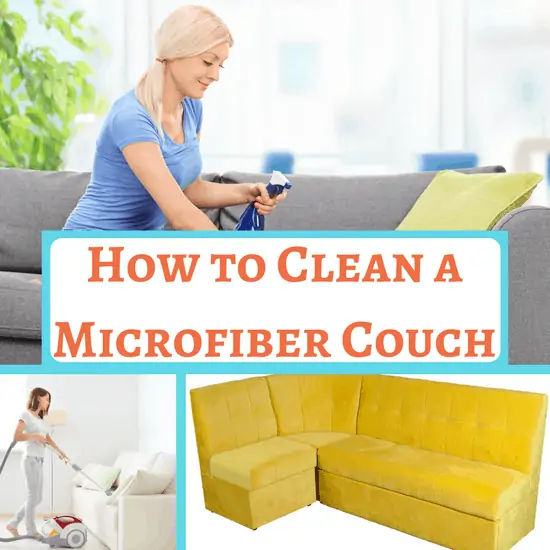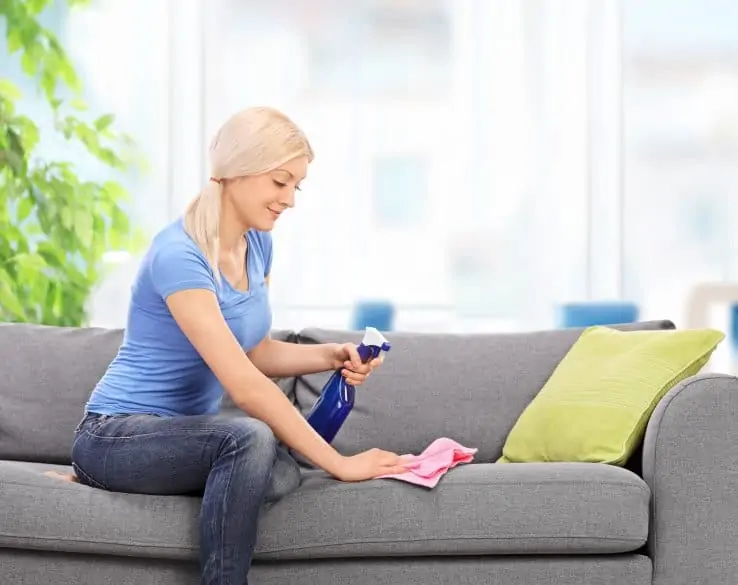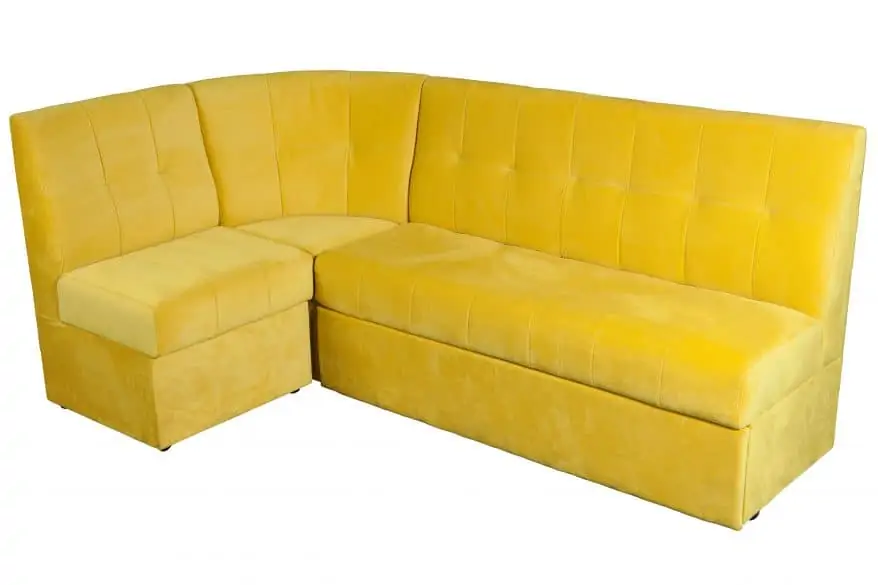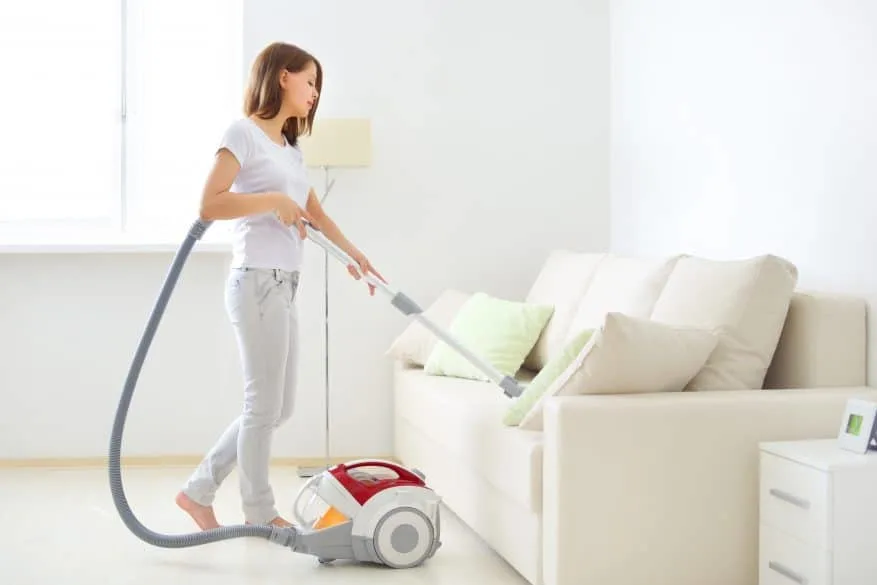Cleaning a microfiber couch can seem like a daunting task, but with the right approach, it can be a breeze. Whether you’re dealing with spills, stains, or just general dirt and grime, there are several effective methods you can use to restore your microfiber couch to its former glory. In this post, we’ll explore step-by-step instructions and handy tips to help you clean your microfiber couch with ease. So, if you’re ready to say goodbye to those pesky stains and hello to a fresh and clean couch, let’s dive in!
The beauty of a microfiber couch is the durability of the material. Microfiber rarely shows wear and looks like new for a long time. And, especially in darker colors, it is difficult to spot dirt on a microfiber couch.
Even better, liquids, in particular, tend to bead up and wipe right off of a microfiber couch. For those stains that manage to stick, your microfiber couch will be easy to clean if you do it correctly. Here’s how to clean a microfiber couch the right way!
How to Clean a Microfiber Couch
Cleaning a microfiber couch doesn’t have to be difficult. Here are our step by step instructions for cleaning a microfiber couch. The good news is these instructions are also great for microfiber chairs or any furniture made out of microfiber fabric.
First off, let’s discuss something- what is microfiber cloth?
Microfiber cloth is a type of fabric that is made out of very fine synthetic fibers. These fibers are usually made from materials such as polyester or nylon, and they are extremely thin and lightweight. The fibers are then woven together to create a cloth that has a soft and plush texture.
Microfiber cloth is known for its high absorbency and ability to trap dirt, dust, and other particles. It is commonly used in cleaning applications because it is very effective at picking up and removing dirt and grime.
Additionally, microfiber cloth is also popular for use in upholstery, like couches and chairs, because it is durable, stain-resistant, and easy to clean. Its tightly woven fibers make it resistant to spills and stains, and it is also resistant to fading and pilling. Overall, microfiber cloth is a versatile and practical material that is widely used in various industries for its cleaning and upholstery properties.
So, now that we know what microfiber furniture is made of, let’s figure out how to clean your microfiber sofa!
1. Read Care Instructions
Before you clean a microfiber couch you need to check the care instructions. When your tag of care instructions has a “W” on it, that means your couch is safe to clean with water.
An “S” means to clean with solvents.
“S-W” means your couch is safe for both water and solvents.
An “X” means to only use a dry brush for cleaning.
Learning to read the manufacturer’s care label will help you find the best way to effectively clean your couch and which type of cleaning solution, if any, that you should use.
2. Soap or Solvent
Looking for how to clean a microfiber couch with home remedies. The good news is that if you have a microfiber couch that is safe to wash with water, you can use items commonly found in your home to clean it.
When you have a microfiber couch that is safe to wash with water, you can use dish soap suds to clean it. Squirt dishwashing soap into a bowl and add water to form suds. Dip your white sponge or cloth in the suds only, not the water.
Use the soap suds to scrub your couch.
After soaping the entire couch, rub it down with a scrub brush of nylon bristles that will nap the microfiber. Now allow it to dry.
How to clean a microfiber couch with alcohol
If your microfiber couch is not water safe, don’t worry, there are still ways to get it clean with common household items.
To clean a microfiber couch that is not water safe you will need rubbing alcohol. This works because rubbing alcohol evaporates so quickly.
Fill a spray bottle with rubbing alcohol and spray any stains or spots on the couch. Then rub each spot with a white cloth or sponge until clean.
Now that you can crack the cleaning code on what to use on the fabric, it’s time to clean it and smooth it out.
3. Smooth Out Fabric
After washing, microfiber fabric can feel stiff to the touch. To work out the stiffness, use the rough side of a sponge or a soft bristled brush to rub the fabric and gently scrub out the stiffness.
Tips for Cleaning a Microfiber Couch
Here are some more helpful tips when it comes to cleaning a microfiber couch.
Use a white sponge or cloth only. A colored sponge might transfer color to your microfiber couch.
Microfiber is less likely to stain if you deal with spills immediately.
For new spills, dab up liquids with a white cloth, DON’T scrub. Microfiber will repel liquids and dabbing should remove the spill without causing a stain.
It’s always a good idea to test your cleaning option out in an inconspicuous area first. Test in a small area to see how the fibers react in the stained area before going crazy and cleaning the whole thing.
No matter what safe cleaning method you choose for your microfiber upholstery, you need to use clean water, fresh cleaning solvent, or rubbing alcohol, etc and use circular motions when working on the fabric. Rubbing it back and forth may cause more wear to the couch and actually may grind the stain or debris in rather than trying to get it out. This is especially helpful when working on tough stains.
How to clean a white microfiber couch
If you are going to clean white microfiber couch, all of the tips still apply. White cloths are really an essential tool for microfiber couch cleaning.
The other thing to consider is the color of the bristles if you are using a brush. Be sure to go with white bristles as well.
Especially with a white microfiber couch, it is very important to first remove any surface debris before cleaning.
Remember, we are using suds made from dish soap for cleaning microfiber sofas in many cases, not the dish soap itself! Never apply colored soaps or cleaners to a white microfiber couch.
Routine Maintenance for Microfiber Couches
Weekly vacuuming will help keep your microfiber couch looking new. If there is no dirt present on your sofa then none can get ground into the fabric. Use the upholstery attachment of your vacuum to remove dirt and help maintain the microfiber fabric.
Vacuuming weekly is especially important if you have pets or children who can dirty up your couch in the blink of an eye.
As soon as a spill happens, you should take the time to clean it up appropriately. The longer you wait, the higher the risk of the stain setting in and becoming a problem.
Quarterly you should thoroughly clean your couch according to the instructions on the care tag. You may need to increase the frequency depending on the conditions your couch gets put in (more often for young, messy kids, or hairy, dirty dogs, etc)
How to prevent a microfiber couch from getting so dirty?
There are indeed several ways to prevent a microfiber couch from getting dirty. Here are some tips to help you keep your couch clean and looking its best:
1. Establish a no-food or drink policy: One of the main culprits of couch stains is spills from food and beverages. By implementing a rule of no eating or drinking on the couch, you can significantly reduce the risk of accidents and stains.
2. Use furniture covers or throws: Consider using furniture covers or throws to protect your microfiber couch from everyday wear and tear. These protective coverings can be easily removed and washed, keeping your couch clean and fresh.
3. Keep pets off the couch: If you have pets, it’s essential to train them to stay off the couch. Pet hair and dirt can easily accumulate on microfiber fabric, making it appear dirty. By establishing designated pet-free zones, you can minimize the amount of dirt and hair that ends up on your couch.
4. Vacuum regularly: Make it a habit to vacuum your microfiber couch on a weekly basis. Use the upholstery attachment to remove dirt and debris from the fabric. Regular vacuuming will help prevent the build-up of dirt and keep your couch looking clean and inviting.
5. Clean spills immediately: Accidents happen, and when they do, it’s crucial to clean up spills promptly. The longer you wait, the more difficult it becomes to remove stains. Use a clean cloth or paper towel to blot the spill gently, avoiding rubbing, which can spread the stain. Then, follow up with a mild cleaning solution recommended for microfiber fabric.
6. Follow care instructions: Every microfiber couch comes with care instructions. Be sure to read and follow these instructions carefully. They will provide guidance on how often to clean and what cleaning products to use. Following the care instructions will help maintain the durability and appearance of your couch.
7. Use a fabric protector: To give your microfiber couch an extra layer of protection, consider applying a fabric protector. This will help the fabric resist stains and is especially helpful if the couch gets used frequently. These products can be purchased at home improvement stores or online through retail outlets. You may have seen Scotchguard, which is a popular type of protector to apply to couches.
Scotchguard helps prevent water stains and dirty stains from forming from everyday use.
8. Spot clean spills: If you do get a spill on your microfiber couch, act quickly! Use a damp cloth to blot up the mess in the affected area– never rub it in – then follow with a cleaning solution of your choice after consulting the care tag, get to work. Remove excess moisture with a terrycloth towel before allowing the fabric to air dry. Repeated spot cleaning over time may cause discoloration, so consider using an appropriate cleaner only when necessary.
Remember, prevention is key when it comes to keeping your microfiber couch clean. By implementing these tips and establishing good cleaning habits, you can enjoy a pristine and inviting couch for years to come.
How to remove grease stains from the microfiber couch?
To remove grease stains from a microfiber couch, follow these steps:
1. Blot the stain: Use a clean, absorbent cloth or paper towel to blot the grease stain gently. Avoid rubbing it, as this can spread the grease and make the stain worse.
2. Absorb excess grease: Sprinkle some baking soda or cornstarch on the stained area to help absorb the excess grease. Leave it on for about 15 minutes to allow it to work its magic.
3. Vacuum: Use the upholstery attachment of your vacuum cleaner to remove the baking soda or cornstarch, along with the absorbed grease. This will help lift the stain and freshen up the fabric.
4. Treat with dish soap: Mix a small amount of mild dish soap with warm water. Dip a clean cloth or sponge into the soapy solution and gently dab it onto the remaining grease stain. Be careful not to soak the fabric, as excessive moisture can damage microfiber.
5. Blot and rinse: After applying the soapy solution, blot the stain gently with a clean cloth to lift the grease. Then, dampen another cloth with plain water and blot the area again with your damp cloth to rinse off any soap residue.
6. Air dry: Allow the couch to air dry completely before using it again. Avoid using a hairdryer or heater to speed up the drying process, as heat can cause microfiber to shrink or warp.
Remember, it’s essential to check the care tag or manufacturer’s instructions for any specific cleaning recommendations for your microfiber couch. If the stain persists or if you’re unsure about the cleaning process, it’s best to consult a professional upholstery cleaner.
How do you get rid of ink stains on a microfiber couch?
To remove ink stains from a microfiber couch, follow these steps:
1. Act quickly: As soon as you notice the ink stain, grab a clean cloth and gently blot the area to absorb as much ink as possible. Avoid rubbing the stain, as this can cause it to spread.
2. Test a small area: Before proceeding with any cleaning method, it’s essential to test it on a small, inconspicuous area of the couch to ensure it doesn’t damage or discolor the fabric.
3. Isopropyl alcohol: Pour a small amount of isopropyl alcohol onto a clean cloth. Gently dab the ink stain with the cloth, starting from the outer edges and working your way towards the center. Be careful not to over-wet the fabric, as it may cause the ink to spread further.
4. Blot with clean washcloth: After applying the isopropyl alcohol, blot the stained area with a clean cloth to lift the ink. Repeat this process until no more ink transfers onto the cloth.
5. Rinse with plain water: Dampen another cloth with plain water and blot the area again to rinse off any remaining alcohol residue. This will also help remove any traces of the ink stain.
6. Air dry: Allow the couch to air dry completely before using it again. Avoid using a hairdryer or heater to speed up the drying process, as heat can cause microfiber to shrink or warp.
If the ink stain persists or if you’re unsure about the cleaning process, it’s best to consult a professional upholstery cleaner as you may need some major cleaning work.
How to get odors out of microfiber couches?
To get rid of odors from your microfiber couch, you can follow these steps:
1. Baking soda: Sprinkle baking soda generously over the surface of your couch. Baking soda is great at absorbing odors. Allow it to sit for at least 15 minutes or overnight if possible.
2. Vacuum: Use a vacuum cleaner with a brush attachment to gently vacuum off the baking soda. This will help remove any trapped odor particles.
3. Fabric freshener: Spray a fabric freshener or upholstery deodorizer onto your couch. Make sure to choose a product specifically designed for upholstery. Follow the instructions on the product for best results and allow it to dry completely.
4. Fresh air: Open windows or use a fan to circulate fresh air in the room. This will help eliminate any lingering odors.
5. Routine cleaning: Regularly vacuum your microfiber couch to prevent odors from settling in. This will also help maintain its overall cleanliness. Quickly removing any stinky pet hair will also help lower the chances of the smell soaking into the couch or lingering.
If the odor persists or if you have any concerns, it’s best to seek professional advice.
